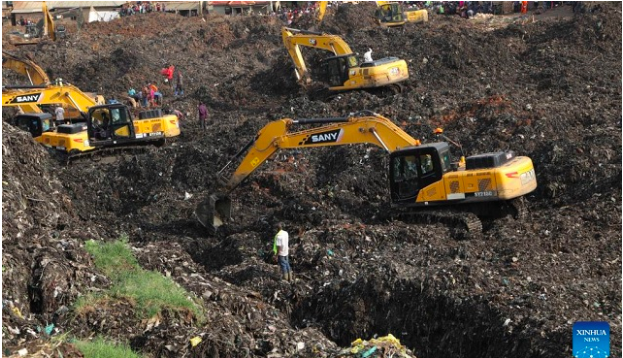
KITEEZI TRAGEDY: Methane explosion might have started garbage landslide.
An explosion of dangerous methane gas may have triggered the recent disaster at the Kiteezi landfill. Survivors of the incident reported hearing explosions from the area where houses were buried before the landfill collapsed.
On Tuesday, Kyadondo East MP Haroon Muwada Nkunyingi suggested in Parliament that a blast from the garbage could have caused the incident. “Witnesses reported a blast that blew up sand and garbage, creating smoke. Residents even allege they saw Chinese workers installing pipes among the mounds of waste,” Muwada stated. “We cannot simply assume this was a natural landslide; it is more likely to have been an accident or negligence, possibly involving the Chinese or KCCA.”
In response, State Minister for Kampala Minsa Kabanda stated that no Chinese nationals were working near the Kiteezi landfill, but she did not comment on the possibility of an explosion. The State Minister for Disaster, Lillian Aber, also did not address the explosion theory. The Kiteezi site has primarily been developed as a land raise with limited engineering efforts prior to its establishment as a landfill. Scientific evidence exists detailing how methane gas explosions can occur at landfills.
Historically, landfill explosions have led to serious accidents. For instance, in 1986, an explosion in Loscoe, England, injured three people. This incident highlighted a lack of understanding regarding operational processes and necessary controls, making the explosion a direct consequence of landfill operations. Another notable explosion occurred on April 28, 1993, at the Ümraniye-Hekimbaşi open dump in Turkey, which resulted in the displacement of solid waste and the deaths of 39 individuals.
Warnings about the Kiteezi landfill have surfaced as early as 2008. Reports from Uganda Radio Network revealed concerns about a possible methane explosion when the site was managed by the defunct Kampala City Council (KCC). These warnings were documented in an Environmental Impact Assessment (EIA) prepared by KCC for a gas-flaring project, part of a broader initiative under the UN Framework Convention on Climate Change’s Clean Development Mechanism (CDM). The report emphasized the risks associated with subsurface migration of landfill gas and highlighted that the Kiteezi landfill had already surpassed its intended lifespan by 2008, having previously experienced a collapse.
The EIA noted that landfill gas, which contains approximately 50% methane—an explosive gas—could migrate underground and accumulate in enclosed spaces, posing significant risks. The report also pointed out the environmental and health hazards associated with uncontrolled emissions of landfill gas, which can adversely affect public health due to the presence of various harmful compounds.
Methane, which is lighter than air and highly flammable, can accumulate in enclosed areas, such as basements. If the concentration of methane reaches between 5% and 15% in the air, it can ignite if exposed to a spark or flame, making it a significant fire hazard. Understanding these risks is crucial in preventing future disasters at landfills like Kiteezi.
